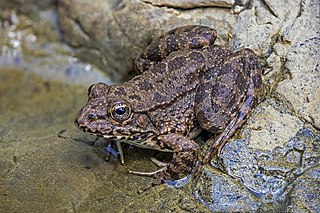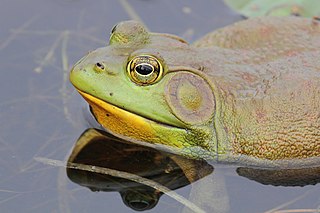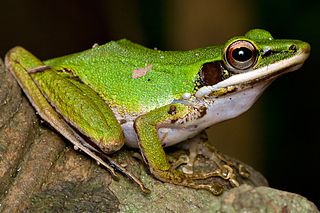
True frogs is the common name for the frog family Ranidae. They have the widest distribution of any frog family. They are abundant throughout most of the world, occurring on all continents except Antarctica. The true frogs are present in North America, northern South America, Europe, Africa, and Asia. The Asian range extends across the East Indies to New Guinea and a single species, the Australian wood frog, has spread into the far north of Australia.

Rana is a genus of frogs commonly known as the Holarctic true frogs, pond frogs or brown frogs. Members of this genus are found through much of Eurasia and western North America. Many other genera were formerly included here. These true frogs are usually largish species characterized by their slim waists and wrinkled skin; many have thin ridges running along their backs, but they generally lack "warts" as in typical toads. They are excellent jumpers due to their long, slender legs. The typical webbing found on their hind feet allows for easy movement through water. Coloration is mostly greens and browns above, with darker and yellowish spots.

Indosylvirana aurantiaca, commonly known as the golden frog, is a species of frog endemic to the Western Ghats of India. The species is also known as the Trivandrum frog, the common wood frog, or the small wood frog.

Lithobates, commonly known as the bullfrogs, is a genus of true frogs, of the family Ranidae. The name is derived from litho- (stone) and the Greek bates, meaning one that treads on rock, or rock climber. As presently defined, it includes many of eastern North America's most familiar aquatic frog species, including the American bullfrog, green frog, and the leopard frogs.

The common green frog is a frog species of in the true frog family Ranidae; some sources still use the old name Rana erythraea. It lives in Southeast Asia and is also known as green paddy frog, red-eared frog or leaf frog. The last name, however, commonly refers to the Neotropical tree frogs which make up the subfamily Phyllomedusinae. These are not closely related to H. erythraea, belonging to family Hylidae instead.

Hylarana garoensis, commonly known as Boulenger's Garo hill frog, Daniel's frog, Swift cascade frog, Garo's hill frog or the Mawphlang frog, is a accepted species of frog in the family Ranidae. H. garoensis' natural habitats are subtropical or tropical moist lowland forests, subtropical or tropical moist shrubland, subtropical or tropical high-altitude grassland, and rivers; it is found in India and possibly Bangladesh. It is threatened by habitat loss.

Hylarana guentheri is a species of frog in the family Ranidae. It was formerly placed in the genus Rana. It is found in China, Hong Kong, Macau, Taiwan, Vietnam, and possibly Cambodia and Laos. An introduced population is found on Guam. It can live as high as 1100 meters above sea level. An alternate common name is Günther's Amoy frog, and the honorific is often spelled "Guenther's".

Humerana lateralis is a species of frog in the family Ranidae. It is found in Cambodia, Laos, Myanmar, Thailand, and Vietnam. It is commonly known as Kokarit frog, yellow frog or (ambiguously) wood frog.

Hylarana latouchii, also known as Kuatun frog, La Touche's frog, or broad-folded frog, is a species of frog in the family Ranidae. It was formerly placed in genus Rana. The specific name honours the collector of the type series: "Hylarana" latouchii was described by George Albert Boulenger based on three specimens collected by Irish ornithologist John D. La Touche in Guadun village in Wuyishan, Fujian, China.

Hylarana tytleri is a frog species in the family Ranidae. It is found in eastern and northeastern India, Myanmar, Bangladesh, and southern Nepal, and possibly at lower elevations in Bhutan. It was formerly placed in Rana, and included in the common green frog. It is probably a close relative of that species nonetheless, and thus placed in the revalidated genus Hylarana, of which H. erythraea is the type species. Common name Theobald's ranid frog has been coined for it, although common names for Indian frogs previously identified as Rana erythraea include yellow-striped frog, leaf frog, and leaping frog.

Hylarana, commonly known as golden-backed frogs, is a genus of true frogs found in tropical Asia. It was formerly considered highly diverse, containing around 84 to 96 valid species, but taxonomic revision resulted in a major change in the contents of the genus, recognizing just four species.

Sylvirana is a genus of true frogs, family Ranidae, found in South and East Asia, from northeastern India in west to China in the north, Taiwan in the east, and Thailand in the south. Originally proposed as a subgenus of Rana in 1992, it has been considered both a full genus and a synonym of Hylarana. Its current recognition at generic level stems from molecular genetic analyses published in 2015.

Chalcorana is a genus of frogs in the family Ranidae, "true frogs". They are found in Southeast Asia, from Thailand to Malay Peninsula and the Sunda Islands.

Papurana is a genus of frogs in the family Ranidae, "true frogs". They are known from Southeast Asia, New Guinea, and northern Australia. Papurana daemeli is the only ranid frog found in Australia.

Hylarana taipehensis is a species of "true frog", family Ranidae. It has several common names, including Taipei frog, Taipei grass frog, two-striped grass frog, or striped slender frog. Following its redelimitation in 2019, its range is now believed to extend from Taiwan and southern China to Vietnam, Laos, Cambodia, and eastern Thailand. It has been observed as high as 800 meters above sea level.
Papurana milleti is a species of true frog. Originally described in the genus Rana, then Hylarana and Indosylvirana, it is now placed in Papurana. It is native to Cambodia, China (Yunnan), Thailand, Vietnam, and quite possibly Laos. It is a locally common frog found by ponds and streams in seasonal tropical forests.

Sanguirana is a genus of true frogs found in the Malay Archipelago, including the Philippines, the Maluku Islands, Sulawesi, and Seram.

Hebius sauteri, commonly known as Sauter's keelback or the Kosempo keelback, is a species of snake in the family Colubridae. The species is endemic to Asia.

















